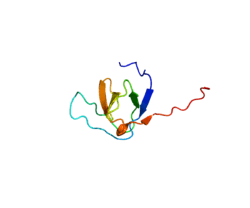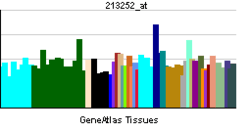SH3PXD2A
SH3 and PX domain-containing protein 2A is a protein that in humans is encoded by the SH3PXD2A gene.[3][4]
References
Further reading
- Ishikawa K, Nagase T, Nakajima D, et al. (1998). "Prediction of the coding sequences of unidentified human genes. VIII. 78 new cDNA clones from brain which code for large proteins in vitro.". DNA Res. 4 (5): 307–13. doi:10.1093/dnares/4.5.307. PMID 9455477.
- Abram CL, Seals DF, Pass I, et al. (2003). "The adaptor protein fish associates with members of the ADAMs family and localizes to podosomes of Src-transformed cells.". J. Biol. Chem. 278 (19): 16844–51. doi:10.1074/jbc.M300267200. PMID 12615925.
- Ota T, Suzuki Y, Nishikawa T, et al. (2004). "Complete sequencing and characterization of 21,243 full-length human cDNAs.". Nat. Genet. 36 (1): 40–5. doi:10.1038/ng1285. PMID 14702039.
- Brandenberger R, Wei H, Zhang S, et al. (2005). "Transcriptome characterization elucidates signaling networks that control human ES cell growth and differentiation.". Nat. Biotechnol. 22 (6): 707–16. doi:10.1038/nbt971. PMID 15146197.
- Deloukas P, Earthrowl ME, Grafham DV, et al. (2004). "The DNA sequence and comparative analysis of human chromosome 10.". Nature. 429 (6990): 375–81. doi:10.1038/nature02462. PMID 15164054.
- Seals DF, Azucena EF, Pass I, et al. (2005). "The adaptor protein Tks5/Fish is required for podosome formation and function, and for the protease-driven invasion of cancer cells.". Cancer Cell. 7 (2): 155–65. doi:10.1016/j.ccr.2005.01.006. PMID 15710328.
- Malinin NL, Wright S, Seubert P, et al. (2005). "Amyloid-beta neurotoxicity is mediated by FISH adapter protein and ADAM12 metalloprotease activity.". Proc. Natl. Acad. Sci. U.S.A. 102 (8): 3058–63. doi:10.1073/pnas.0408237102. PMC 549444
 . PMID 15710903.
. PMID 15710903.
- Harold D, Jehu L, Turic D, et al. (2007). "Interaction between the ADAM12 and SH3MD1 genes may confer susceptibility to late-onset Alzheimer's disease.". Am. J. Med. Genet. B Neuropsychiatr. Genet. 144 (4): 448–52. doi:10.1002/ajmg.b.30456. PMID 17440933.



 . PMID 9687503.
. PMID 9687503. . PMID 15710903.
. PMID 15710903.